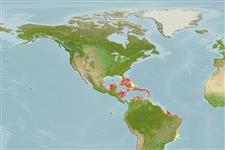Common names from other countries
>
Eupercaria/misc (Various families in series Eupercaria) >
Labridae (Wrasses) > Xyrichtyinae
Etymology: Xyrichtys: Greek, xyreo = that cuts like a knife + Greek, ichthys = fish (Ref. 45335).
More on author: Castelnau.
Environment: milieu / climate zone / depth range / distribution range
Ecologia
marinhas associadas(os) a recifes; intervalo de profundidade 3 - 15 m (Ref. 9710). Subtropical; 32°N - 33°S
Western Atlantic: Bermuda and southern Florida (USA) to Brazil; throughout the Caribbean Sea.
Tamanho / Peso / Idade
Maturity: Lm ? range ? - ? cm
Max length : 17.5 cm TL macho/indeterminado; (Ref. 9626)
Adults have a vertically elongate blue spot on each scale, the head has alternating vertical lines of pale blue and brownish orange, but these are broader than on X. novacula; adult males are more green in overall color and have a blue-edged inky black spot on midside of body within a pale region of pink or yellow (Ref. 13442).
Most common in shallow, sandy areas in and around seagrass beds. Prefers clear waters (Ref. 9626). Generally of no interest to fisheries because of its small average size (Ref. 5217).
Ciclo de vida ou comportamento de acasalamento
Maturities | Reprodução | Spawnings | Egg(s) | Fecundities | Larvas
Robins, C.R. and G.C. Ray, 1986. A field guide to Atlantic coast fishes of North America. Houghton Mifflin Company, Boston, U.S.A. 354 p. (Ref. 7251)
Status na Lista Vermelha da UICN (Ref. 130435)
CITES (Ref. 128078)
Not Evaluated
Ameaça para os humanos
Harmless
Uso pelos humanos
Pescarias: espécies comerciais; Aquário: Espécies comerciais
Ferramentas
Relatórios especiais
Baixar XML
Fontes da internet
Estimates based on models
Preferred temperature (Ref.
115969): 26.3 - 28.2, mean 27.5 (based on 588 cells).
Índice de diversidade filogenética (Ref.
82804): PD
50 = 0.5005 [Uniqueness, from 0.5 = low to 2.0 = high].
Bayesian length-weight: a=0.00813 (0.00406 - 0.01629), b=3.07 (2.89 - 3.25), in cm Total Length, based on LWR estimates for this species & (Sub)family-body (Ref.
93245).
Nível Trófico (Ref.
69278): 3.2 ±0.1 se; based on diet studies.
Resiliência (Ref.
120179): Elevada, tempo mínimo de duplicação da população menor que 15 meses (Preliminary K or Fecundity.).
Fishing Vulnerability (Ref.
59153): Low vulnerability (10 of 100).
